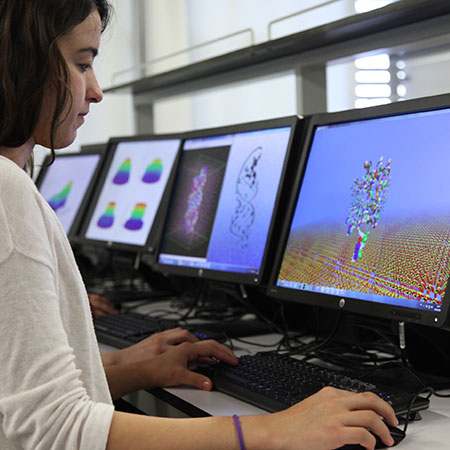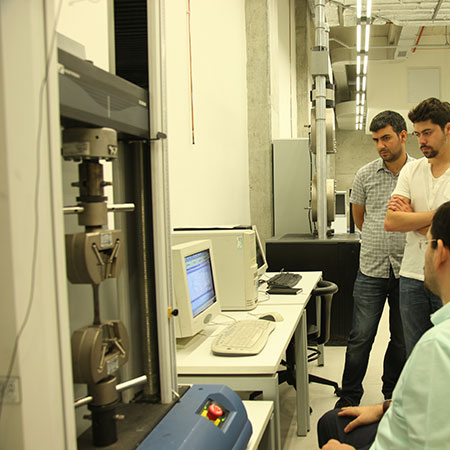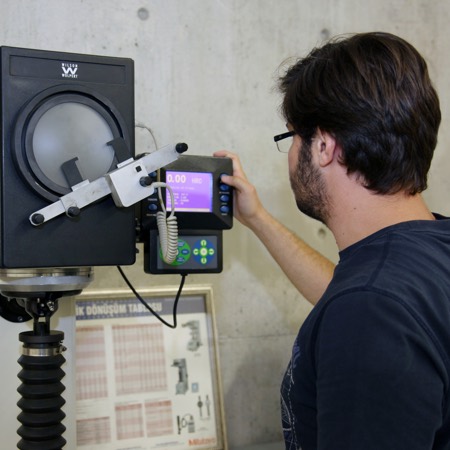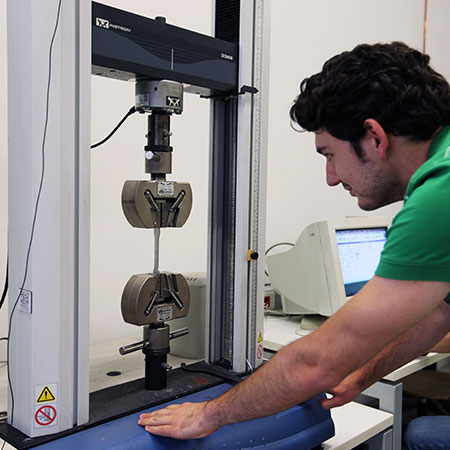Electrical and Electronics Engineering Graduate Programs
Master's Programs (With Thesis)
Master's programs with thesis should be completed within a maximum of 4 semesters. Students who have successfully completed the course load, the seminar, and the publication ethics courses, but fail to take the thesis defense due to the failure to complete the work on the dissertation within 4 semesters can be granted a extension of 2 semesters.
Before taking the ELE 599 Thesis course, the students should complete their course load obligations in the preceding semesters.
The master's program with thesis is structured as follows:
- 7 courses (for an minimum overall credit count of 21)
- ELE 597 Seminar (no credit)
- FBE 600 Scientific Research Techniques and Publication Ethics (no credit-must)
- Master's Programs (Without Thesis)
Master's Programs (Without Thesis)
Master's programs without thesis should be completed within a maximum of 4 semesters. Students who fail to complete the program within the said time frame can be granted a maximum extension of 2 semesters. Time spent for the scientific preparation program will not be included in the time frame stipulated for the master's program. The master's program without thesis is structured as follows:
- 10 courses (for an minimum overall credit count of 30)
- FBE 600 Scientific Research Techniques and Publication Ethics (no credit - must)
- ELE 598 Graduation Project (no credit)
Note:
- In master's programs with or without dissertation, the students can take a maximum of three courses with 4xx codes, as part of the course load.
- In master's programs with or without dissertation, the students should take at least half of the required course load from among the courses offered in their own department, or other courses approved by the department.
Courses
| ELE 501 | Linear Systems | 3 Credits |
| Review of transformation techniques. Linear spaces. Linear operators. Value space and free space. Essential vectors. Singular value distinction (SVD). Norms. Definition of linear systems: input, output and state variable definitions; definitions of systems static or variable through time. Discrete time systems. Modal distinction. Analysis of linear systems: auditability, observability, and stability | ||
| ELE 502 | Optimal Control | 3 Credits |
| Foundations of the estimation theory. Discrete time Kalman filtering Continuous time Kalman filtering Design and implementation in Kalman filters. Estimation in non-linear systems. Optimal stochastic control for state-space and polynom systems. | ||
| ELE 503 | Non-Linear Systems | 3 Credits |
| Non-linear behavior, analysis in phase space, Lyapunov stability analysis and definitions, defining function analysis, Lie algebra, feedback linearization, input / output linearization, input / state linearization, zero dynamics and internal stability, sliding mode control, non-linear observers, applications in robotics and mechatronics. | ||
| ELE 504 | Digital Control Systems | 3 Credits |
| Nyquist sampling theorem, z-transformation, reverse z-transformation, convolution, first-value theorem, last value theorem, types of differential equations (MA, AR, ARMA, ARMAX), approximation methods to derive G(z) from G(s), matching between s-domain to z-domain, obtaining z transform statements for block diagrams, stability analysis, Jury stability test, Routh criterion, Validation methods (Direct, Serial, Parallel and Ladder), Stable state error analysis, root locus and design, Raggazzini s direct design method, discrete PID controller, expression of state-space in discrete time, structural characteristics (controllability, observability), Lyapunov stability analysis for discrete systems, pole positioning (Bass-Gura and Ackermann methods), discrete-time monitors. | ||
| ELE 505 | System Diagnostics | 3 Credits |
| Systems and models. Classical diagnosis methods: stimulus, step, and sinusoid signal tests, Diagnosis methods based on correlation functions. Parameter estimation methods: smallest squares, generalized smallest squares, supporting variables methods, prediction error method, largest probability method. Recursive parameter estimation method. Recursive diagnosis of linear models changing over time. Model validity testing. | ||
| ELE 506 | Robust Control | 3 Credits |
| Robustness problem in control systems. Sensitivity and uncertainty. Robust stability and stabilization. Kharitonov and polynom applications. Lyapunov and matrix applications. Transfer function applications. Robust control system design: H2 and H¥ control methods, m-synthesis method, quantitative feedback theory | ||
| ELE 507 | Multi-Variable Control | 3 Credits |
| Multi-variable system description, SSD, TMD, MFD, PMD. Controllability, Observability. Kalman decomposition. Polynomial matrices: Irreducible MFD, gcrd, gcld. Wolovich structure theorem. State feedback. State microscope. Decoupling. Smith-McMillan form. Multi-variable pole and zeros. Closed-loop stability. Introduction to optimal control. | ||
| ELE 508 | Adaptive Control | 3 Credits |
| System models. Parameter estimation. Model-based adaptive control: MIT and SPR rules. Self-adjusting control: Automatic adjustment, gain listing. Stability, convergence and robustness. | ||
| ELE 509 | Flow Control | 3 Credits |
| Finite dimension and infinite dimension systems, achieving numerical solutions to partial differential equations, border control problem, singular value distinction, balanced model reduction, modeling problems, single-dimension cases, two-dimension cases, adaptive orthogonal decomposition, fluid dynamics applications. | ||
| ELE 511 | Robotics and detection | 3 Credits |
| Robot arms (manipulators), robot arm kinematics, manipulator orbit planning, detection systems, distance detection, close detection, detection by touch, mobile robots; mapping, orbit planning, navigation, obstacle avoidance, target definition, target tracking. | ||
| ELE 512 | Flight Control Systems | 3 Credits |
| Movement dynamics of airplanes. Dynamics and stability of airplanes. Reviewing control systems design methods. Stability reinforcement systems. Orientation control systems. Flight route control systems. | ||
| ELE 513 | Artificial Neural Networks | 3 Credits |
| Information presentation and learning styles. Adaptation and generalization with neural networks. Structure of the basic unit of shared neural network in comparison with biological neurons. Perceptron and multi-level perceptron. Fault back-propagation learning algorithms. Fuzzy logic control with fault back-propagation algorithms. Radial base functions and learning strategies. Temporary processing: temporary fault back-propagation, recurrent and dynamic networks. Instructor-less networks and learning rules. Applications of neural networks in the system theory, and recent developments. | ||
| ELE 514 | Fuzzy Logic | 3 Credits |
| Clear and fuzzy variables, membership functions and membership values, rule base, parametric membership functions, blur, clarification methods, inference, antecedent merging, rule activation level, function verification / approximation, adaptive fuzzy systems, applications of fuzzy logic, and a glance at the details regarding application. | ||
| ELE 515 | Computerized Control with MATLAB | 4 Credits |
| MATLAB/Simulink installation, general information on the software. Introduction to MATLAB/Simulink, general use, programming. Signal processing perspectives. Modeling, transfer function generation, state-space expressions. Derivative, proportional, integral (PID) controllers. Root locus curve, Bode frequency response. Digital control systems. Various engineering applications and cases. | ||
| ELE 516 | Smart Systems | 3 Credits |
| Concepts of Intelligence and Artificial Intelligence (AI). AI paradigms. AI elements. AI techniques: Fuzzy logic, genetic algorithm, taboo research, specialized systems and Artificial Neural Networks (ANN). Introduction to ANN. Forward feed networks, learning algorithms with instructors. Use of ANN in industrial applications, fuzzy logic, control applications. | ||
| ELE 517 | Artificial Sight | 3 Credits |
| Inference of low-level characteristics, border and region-based analysis, segmentation and grouping, brightness and color, shade effects and information generation using shady images, photometric and binocular stereo, optical flow and movement, estimation, definite and weak modeled sight, integration of sight systems, real-time sight. | ||
| ELE 518 | Herd Systems | 3 Credits |
| Recent developments in and critical review of multi-element (herd) systems. Analogies between the behavior of animal herds and robot herds; mathematical modeling and analysis of such analogies. Interaction between elements in herds composed of simple elements; collective and distributed intelligence; coordination and smart systems. | ||
| ELE 519 | Embedded Systems | 3 Credits |
| Areas of application of embedded systems and project management. Microprocessor structures, CPLD and FPGA architecture, VHDL Programming. Test bench software and debugging. Bus standards, Parallel Bus, ARM bus, PLB, UART, SPI, I2C, TDM, Ethernet, Physical Interfaces. Processor design with FPGA. Other elements of embedded systems, A2D, D2A | ||
| ELE 520 | Physics of Semiconductor Devices | 3 Credits |
| ELE 521 | Microwave Electronics. | 3 Credits |
| Active and passive system analysis on the basis of distribution parameters, elements of microwave circuits, pairing circuits, amplifiers, analysis of microstripe lines and other transmission environments, microwave integrated circuits. | ||
| ELE 522 | CMOS VLSI Design | 3 Credits |
| Review of the foundations of microelectronics. CMOS and BiCMOS technologies. CMOS fab methods. CMOS design processes and issues. Design rules. Basic electrical and circuit features: Delay, timing etc. Synchronized and asynchronized circuits. Resizing and limits. Practical issues and tests. Simulation. | ||
| ELE 523 | Analog Integrated Circuits | 3 Credits |
| BJT and MOSFET models. Foundations of analog integrated circuit production. Single-transistor amplifier levels. Multi-transistor amplifier levels. Current and voltage foundations. Exit levels. Single-exit operational amplifier circuits. Two-level operational amplifier circuits. | ||
| ELE 524 | Advanced Analog Integrated Circuits | 3 Credits |
| At high frequencies called microwave frequencies, all circuit elements operate on the basis of different principles. At such high-frequency ranges, circuit analysis, simulation and design techniques also vary. This course discusses these issues. Comparators, adaptive polarization circuits, analog multipliers. Schmitt triggers. Local oscillator circuits.. Load pumps. Phase comparator. Phase locking loop (PLL). | ||
| ELE 525 | CMOS Mixed Signal Integrated Circuits | 3 Credits |
| Today, application-specific integrated circuit designs include both digital and analog circuit elements. These circuits are called mixed signal circuits. Digital- or analog-only analysis and design methods are not adequate alone to discuss these circuits. This course discusses mixed-signal circuits.Foundations and characteristics of data inverter circuits. Models and architectures of data inverter circuits.Inverters shaping noise spectrum. R-2R, current and voltage mode digital-analog converters. Sample-and-hold circuits. Analog-digital converter circuits. | ||
| ELE 526 | Analog Filter Integrated Circuits | 3 Credits |
| Foundations and characteristics of analog filters. Effective-RC, MOSFET-C, gm-C filters. Switched capacitance filters. Switched voltage filter circuits. Log-region and square-root region filter circuits. | ||
| ELE 527 | Instrumentation and Experimental Methods | 3 Credits |
| Application of statistical analysis in measurement systematics, data gathering in measurement systems, introduction to programming with LabView, data gathering with Temperature/Vibration/Pressure sensors, basic electronic circuits in assessment and instrumentation, experiments with various applications. | ||
| ELE 528 | Superconductor Electronics I | 3 Credits |
| Superconductor theories (Ginzburg-Landau theory, BCS theory), electrodynamics of superconductors in weak magnetic fields, Josephson joints, Meissner state with superconductors, theories and technologies for type-II superconductors, applications in power electronics (cables, motors, generators, incorrect voltage limiters, maglev), sensor and VLSI applications (magnetocardiography, magnetoencephalography, non-destructive test systems, defense and space applications) | ||
| ELE 529 | Superconductor Electronics II | 3 Credits |
| Applications of superconductor electronics, superconductor-based optical/thermal sensors (transition edge bolometers, hot electron bolometers), Josephson joints, superconductor-based magnetic field sensors, computer-assisted design tools, rapid single-flux quantum based circuits, superconductor integrated circuit design techniques, very low temperature characterization techniques and systems | ||
| ELE 530 | Advanced Electromagnetics Theory | 3 Credits |
| ELE 531 | Microwaves | 3 Credits |
| A brief revisiting of the electromagnetic wave theory. Frequency- and time- domain analysis of transmission lines. Rectangular and circular wave guides. Microwave system equivalent circuit analysis. Passive and active microwave circuit elements. Impedance conversion and impedance match techniques. Microstripe orders. | ||
| ELE 532 | Antennae and Emission | 3 Credits |
| Antenna parameters. Linear antennae. Radiation diagrams of antennae and impedance. Antenna arrays. Reflector antennae. Introduction to ground waves and propagation. Introduction to radar systems. | ||
| ELE 533 | Digital Methods in Electromagnetics | 3 Credits |
| Electromagnetic field equations in time- and frequency-domains, numerical solutions of differential and integral equations, finite-margin and finite-element methods, moments method, quick solution techniques | ||
| ELE 536 | Neuro Engineering I | 3 Credits |
| Introduction to the electrical characteristics of cells: Cellular electrical potentials, potential production mechanism of the membrane, the role of electrical potential in information coding, huge axon of squid. Batch-parameter model of cells, distributed-parameter model of cells: Electrical variables, electrical small cells, electrical large cells. Linear electrical characteristics of cells: Electrical characteristics of cell membranes, electrical small cells, electrical large cells (cable model) Hodgkin-Huxley model: Voltage-clamp technique for understanding ionic mechanisms, the synthesis of Hodgkin-Huxley model, Description of the electrical excitability of huge axon. | ||
| ELE 537 | Neuro Engineering II | 3 Credits |
| Ion Channels: Rapid signalization’s connection with ion channels in the neural system, ion channels encircling the cell membrane, registration of the current in singular ion channels, characteristics of ion channels, biophysics of ion channels, structure in the light of biochemistry and molecular biology studies.Membrane Potential and Passive Electrical Characteristics of the Neuron: Development of the cell membrane rest potential due to decomposition of the charges around the cell membrane, determination of the cell membrane rest potential by the open-closed ion channels, loss of the ion flow balance which sets the cell membrane rest potential through the action potential, using Goldman equations to define the contributions of various ions in cell membrane rest potential, expression of the neuron’s electrical equivalent circuit, the impact of the neuron’s passive electrical characteristics on electrical signalization.Action Potential: Development of action potential through the flow of ions from voltage-gated channels, the development of the neuron’s signalization capacity through the changes in the characteristics of voltage-gated ion channels, ion permeability and the definition of voltage-gated channels’ mechanisms through electrophysiological measurements, the growth of calcium, sodium, and potassium voltage-gated channels through the same root and their shared characteristics. | ||
| ELE 541 | Biomedical Engineering | 3 Credits |
| Basic principles of biomedical devices. Basic converters and related principles, Sources of biopotentials. ENG, EMG, EKG, ERG, EEG. Biopotential electrodes. Physiology of and measurements on the nervous, circulatory, and respiratory systems. Biopotential amplifiers. Patient care and monitoring systems. Treatment and life-support devices. | ||
| ELE 542 | Medical Imaging | 3 Credits |
| Nuclear radiation and radioactivity; foundations of nuclear radiation detection and measurement techniques; Radiotherapy and the biological impact of radiation; Medical imaging structuring techniques; Computer-assisted tomography; Ultrasound imaging; Nuclear magnetic resonance techniques; Applications of lasers; Termography | ||
| ELE 543 | Biomedical Signal Processing | 3 Credits |
| Development of biological markers and general characteristics thereof. Bio-markers with electrical, acoustic, mechanical and bio-chemical sources. Identification of biological markers. Application of certain marker processing methods in the field of bio-marker processing; random operations; digital marker processing; frequency domain analysis; time series analysis and linear projection; spectral estimation; adaptive filtering and shape recognition. Examples of filtering and signal enhancement, pre-processing and identification of characteristics. | ||
| ELE 544 | Biomaterials | 3 Credits |
| An overview of biomaterials, material characterization, metals, ceramics, polymerical implants used as bio-compatible materials, controlled drug release, composites, biological tests applied on biomaterials, determining surface characteristics and measurement techniques, using physico-chemical and mechanical tests to determine change in structural characteristics, tissue compatibility in implants (for soft and hard tissues such as skin, blood, or bones). | ||
| ELE 545 | Bioelectrical Events | 3 Credits |
| Bioelectric sources. Field a single cell creates in the tissue. Development of action potential and progress through fibers. Cylindrical structures and the potential to arise with them. Transmission line theory. Body surface potential and its relationship with the sources in the heart. Potential in non-homogeneous environments. Electrocardiography. Reciprocity. Advanced linear problems and reverse problems. Plethysmography of impedance. Tomography of impedance. Digital methods. Image method. | ||
| ELE 546 | Bioelectrics and Biomagnetics. | 3 Credits |
| Vector analysis. Sources and fields of electricity. Introduction to the biophysics of the cell membrane. Action potential. Electro-physiology of the heart. Electrocardiography (ECG). Electrical and magnetic fields. Electroencephalography (EEG). Magnetic electroencephalography (MEG). | ||
| ELE 547 | Biomedical Optics | 3 Credits |
| Spectroscopy (SPY). EM radiation-matter interaction. Ultraviolet and visible wave SPY. Wave propagation and dispersion in random environments. Radiation in tissue. Monte-Carlo method. Radiative transfer theory. Florescence spectroscopy. Laser-tissue interaction and the generation of heat. Applications. | ||
| ELE 548 | Biological Effects of Electromagnetic Waves | 3 Credits |
| Sources, dispersion, and absorption of electromagnetic waves. Interaction of low-frequency waves with people. Electromagnetic characteristics of biological tissues. Cellular and molecular effects of electromagnetic waves. Interaction of high-frequency waves with people; inducted fields and currents. SAR and thermal effects. The use of electromagnetic waves in treatment, and hyperthermia. Methods to determine interaction, assessment and measurement methods and patterns. Types of exposure, epidemiological studies, laboratory experiments, animal and tissue experiments. International standards and applications. | ||
| ELE 549 | Biomechanics and Tissue Mechanics | 3 Credits |
| Basic issues in linear viscoelasticity, mechanical models, viscoelastic functions, Boltzmann constant, integrals, dynamic behavior of linear viscoelastic materials, quasi-linear viscoelasticity. Characteristics of tissues, theories and models of the viscoelastic behavior of tissues. Clinical applications of tissue mechanics. | ||
| ELE 551 | Optics | 3 Credits |
| Geometric optics, wave optics, Fourier optics, interference, scattering, optical filters, polarization, dispersion of light, optical wave guides, resonators, fibers, statistical optics. | ||
| ELE 552 | Photonics | 3 Credits |
| Introduction to photonics; the science and technology of controlling photons. Photon theory of light, and the interference of light with matter: Sudden emission, absorption, and supported emission. Lasers and laser amplifiers. Generic lasers and special laser systems. Semiconductor lasters, light emitting diodes, and light detectors. Other electro-optics and electro-acoustics based devices. Non-linear optics. | ||
| ELE 553 | Optical Communications | 3 Credits |
| Contents of optical transmission systems. Optical interconnects. Optical fibers. Optical sources. Principles of lasers. Optical detectors. Optical devices. Point-to-point communication systems. Single-channel systems. Modulation. Multi-state coding. Signal sensing. Physical limitations and characteristics of transfer systems. Spectrum analyses. Optical network technologies and network topologies. | ||
| ELE 554 | Opto-Electronics | 3 Credits |
| Insulator waveguides and optical fibers. Semiconductor physics, LEDs, Lasers and Optical amplifiers, modulators, switched, various optical communications devices (WDM). Current research topics, plasmonic and photonic crystals. | ||
| ELE 555 | Fourier Optics and Holography | 3 Credits |
| Application of Fourier transform and linear systems theory on optical events; radiation and scattering of light; light interface modulation; optical signal processing; Fresnel and Franhoufer approaches; display characteristics of lenses; analysis of optical imaging systems; analog and digital optical signal processing; holography. | ||
| ELE 556 | Lasers | 3 Credits |
| ELE 557 | Solar Power Systems | 3 Credits |
| Fundamentals of solar power technology, design and applications, solar power conversion, solar cells, photo-electro-chemical cells, thermo-electrical sources, energy distribution and storage. Trends in photo-voltaic technology, solar panel production techniques, material knowledge, environmental impacts. Brief information on other alternative energy sources such as wind and biomass. | ||
| ELE 560 | Digital Coding of Signals | 3 Credits |
| ELE 561 | Wireless Communications | 3 Credits |
| Wireless transmission, media access control, multiplexing techniques, communication systems, GSM, satellite systems, broadcast systems, wireless LAN, mobile TCP, mobility support. | ||
| ELE 562 | Satellite Communication Systems | 3 Credits |
| Basic structure of satellite communication systems. Ground terminal, antennae, transmitters, and factors affecting receiver performance. Orbit analysis, equatorial, polar, and oblique orbits. Circular and elliptical orbit. Low-, medium-, and synchronized orbits. Basic structure and characteristics of satellites. Link design. Communication environment and the impact of wave radiation on link design. Analog and digital satellite communication systems. TV broadcasts on satellites. UHF, SHF and EHF satellite communication systems. Brief description of certain operating systems such as INTELSAT, EUTELSAT, INMARSAT and GPS. Examples of mobile SATCOM systems | ||
| ELE 563 | Communication Networks | 3 Credits |
| Phone, internet, wireless networks; architecture and protocols, direction algorithms, network design and management systems, network simulation and performance analysis, traffic measurement, layered network structures, error control mechanisms, package switching, multiplexing methods, network security. | ||
| ELE 564 | Digital Communications | 3 Credits |
| Brief revisiting of modulation techniques such as M-li ASK, M-li PSK, M-li FSK, and M-li QAM. Bug tracking and correcting coding techniques. Block and convolutional coding. Embedded coding and modulation, Trellis coded modulation. The impact of coding for multiple modulation systems, on the bit-error rate. Coding gain. Spread spectrum techniques, direct sequence, frequency stepping and hybrid systems. Probability theory and a brief repetition of probabilistic processes. Sum of random variables. Central limit theorem. Fading channel classification. Fading with and without frequency selection, rapid and slow fading. Shading. The impact of fading and shading on bit error rate. Variation and merging methods. Selective, switching, equal power and maximum rate merging. Merging before and after detection. Multiple access methods, FDMA, TDMA, CDMA, ALOHA, CSMA, token ring. The impact of fading on data transfer rates. | ||
| ELE 565 | Fundamentals of Radar Signal Processing | 3 Credits |
| Signal Models, Sampling and Quantization, Waveforms, FMCW radar signal prosessing, Doppler processing, CFAR, Synthetic Aperture Radar Imaging | ||
| ELE 566 | Mobile Communication Systems | 3 Credits |
| Propagation medium in mobile communications. Fading and shading. Propagation loss on flat and hilly terrain. Communications inside and outside buildings. Impact of plants, trees, buildings etc. Calculation of fading time and rate. Methods to limit the negative effect of fading. Interference sources in mobile communication systems, and the assessment of their impact. Frequency planning and the concept of cells. Foundations of system design. Brief introduction to some mobile communication systems, GSM, DECT, IS-95, Personal communication service, air-land communications, satellite communication systems with mobile users. | ||
| ELE 567 | Machine Learning for Communications Systems | 3 Credits |
| Basic concepts of machine learning; fundamental software for machine learning, MATLAB, Python, Keras; Example communications applications. | ||
| ELE 568 | Network Science | 3 Credits |
| Basic concepts and tools of network science, network calculus, data analysis in network science applications, chemical networks, physical networks, biological networks, network science in city and regional planning, social networks, network science applications in fine arts, analyzing economical data in terms of network science, sociological network applications , other applications. | ||
| ELE 569 | Optimization of Communication Networks | 3 Credits |
| Optimization under restrictions, mathematical system modeling, linear programming, simplex method, integer programming, mixed integer programming, network flows, optimization modeling on networks and diagrams, work flow modeling and optimization, mixed integer programming solutions with branching and restriction algorithms, internal point solutions, dynamic programming, genetic algorithms, annealing simulation, models for optimization on wireless sensor networks, optimization models on mobile ad hoc networks, optimization models for signal processing, optimization models for cellular communication systems, optimization models for information and network security, optimization models for human-machine interaction, optimization models for smart networks. | ||
| ELE 571 | Detection and Estimation Theory | 3 Credits |
| Random parameters. Bias estimation. Unbiased estimation with minimum variation. Cramer-Rao threshold. Linear models. Linear unbiased estimations. Maximum probability estimation. Smallest squares method. Moments. General and linear Bayesian estimations. Description of parameter estimations. Description of signal estimation. | ||
| ELE 572 | Information Theory | 3 Credits |
| Definition of information, shared information, uncertainty criteria, information sources and source coding, data compression, channels and channel capacity, noisy channels, limits of data transmission performance. | ||
| ELE 573 | Digital Image Processing | 3 Credits |
| Fundamentals of digital image processing. Image analysis. Edge recognition techniques. Grayscale image analysis. Binary image analysis. Pattern recognition and analysis. Pit analysis. Frequency domain analysis. Wavelet decomposition. Optical character recognition. Symbol recognition. | ||
| ELE 574 | Random Processes | 3 Credits |
| Revisiting the probability theory, Bernoulli process, Poisson process, Markov Chains, Bayesian estimation, Hypothesis testing, MAP Rule, LMS estimation, Parameter estimation, Regression. | ||
| ELE 575 | Pattern Recognition | 3 Credits |
| Basic concepts of pattern recognition, pattern categories, characteristics of patterns, identification of characteristics, classification. Statistical decision making theory, linear determinant functions, Bayesian classifier. Learning with a teacher; estimation of probability density functions; adequate statistics and the largest probability estimation. Non-parametric pattern recognition methods, nearest neighbor and k-nearest neighbor rules, canted climb methods and smallest squares algorithms. Learning without a teacher, clustering, estimation of characteristics with orthogonal series. Grammar-based pattern recognition. | ||
| ELE 576 | Speech Processing | 3 Credits |
| Basic characteristics of speech signal. Quantization. Feature identification. Modeling of speech signal. Hidden Markov models. Speech recognition, synthesis, and coding techniques. | ||
| ELE 577 | Adaptive Signal Processing | 3 Credits |
| Average square error performance surface. Adaptive linear combiner. Search techniques and adaptive algorithms. Fastest descent algorithms. Newton and LMS algorithms. Misadjustment and excess mean square error (MSE). Parallel modeling, reverse modeling, and interference removal architectures. Cases. Adaptive lattice structure. | ||
| ELE 578 | Digital Coding of Signals | 3 Credits |
| Sampling, digitization, adaptive coding, sound, image and video codes, JPEG and MPEG standards, error coding, optimal codes, compression codes. | ||
| ELE 579 | Statistical Signal Processing | 3 Credits |
| ELE 581 | Power System Analysis | 3 Credits |
| Introduction to power systems and system elements. Transmission line parameters and transmission line models. Short, medium and long line solutions. Modeling of power systems. Single line and reactance diagrams. Symmetrical short-circuit analysis on power systems. Symmetrical components. Positive, negative and zero-component circuits of power systems. Phase-earthing, double phase-earthing, and phase-phase asymmetrical short circuit analysis in power systems. Bus bar admittance matrix and introduction to load flow. Gauss-Seidel and Newton Raphson methods and load flow analysis. | ||
| ELE 582 | Electrical and Hybrid Vehicles | 3 Credits |
| Electric propulsion and transmission systems; various hybrid (series, parallel, series-parallel, mild-hybrid) and elektrical vehicle (plug-in electric vehicles, fuel-cell) structures, performance ve current examples; Electrical and hybrid vehicle dynamic model, case studies (Zip Car, İETT); battery types, selection, charge/discharge control and battery management systems; charge systems, power levels, infrastructure requirements, design criteria; efficiency concepts; EVs in public transportation; Innovative approaches (interaction with the grid, G2V and V2G , alternative electrical energy resources and integration, autononomous systems etc.) | ||
| ELE 583 | Electricity Markets | 3 Credits |
| Engineering, economics, legal and environmental aspects of electrical power systems from an interdisciplinary perspective: Foundations of electrical power systems, liberal electrical market structures, supply safety, reserve capacity and capacity markets, demand management, sustainable energy systems, clean energy sources, carbon emission markets, integration of variable and limited-time sources, distributed generation, smart grids. | ||
| ELE 591 | Special Topics in Quantum Technology | 3 Credits |
| This course provides a comprehensive introduction to FPGA programming and its advanced applications in controlling and measuring superconducting qubits. No prior knowledge of quantum physics or FPGA is required. The learning outcomes of the course are: LO1: Gain extensive knowledge in the field of FPGA design, LO2: Gain experience in hardware-software co-design, LO3: Learn FPGA-based signal processing for superconducting circuits-based quantum experiments, LO4: Learn implementation techniques of the modules for fast quantum signal acquisition and state detection, LO5: Learn implementation techniques of the electronics used for controlling quantum experiments, LO6: Learn experiments used for qubit characterization and techniques for measurement fidelity optimization. | ||
| ELE 593 | Introduction to Quantum Computing | 3 Credits |
| The physical foundations of quantum computing are introduced through spin and polarization examples. Linear algebra, vector spaces, and the concepts of bra and ket as they will be used in quantum computing are covered. Entanglement models, the most fundamental phenomenon in quantum computing, are introduced. Classical and quantum logic gates and circuits are examined. Quantum algorithms are introduced and processed with the fundamentals acquired up to this stage. Quantum algorithms are implemented with simulation and real qubits using the Python language. | ||
| ELE 594 | Advanced Topics in Quantum Computing | 3 Credits |
| This course consists of three parts. In the first part, aspects of quantum mechanics, especially those looking at quantum computing, are covered through comprehensive mathematical models. The basics of the calculation part are also summarized and explained in this section. The second part focuses on quantum circuits, quantum algorithms and quantum computers. In the third part, quantum information theory is discussed in detail | ||
| ELE 596 | Special Topics in Electrical Engineering | 3 Credits |
| ELE 597 | Seminar | 0 Credits |
| ELE 598 | Semester Project | 0 Credits |
| ELE 599 | Master's Thesis | 0 Credits |
| ELE 623 | Advanced Analog Integrated Circuits | 3 Credits |
| ELE 625 | CMOS Mixed Signal Integrated Circuits | 3 Credits |
| ELE 626 | Analog Integrated Circuit Filters | 3 Credits |
| ELE 654 | Fiberoptics Systems | 3 Credits |
| ELE 662 | Satellite Communication Systems | 3 Credits |
| ELE 663 | Communication Network Analysis | 3 Credits |
| ELE 666 | Mobile Communication Systems | 3 Credits |
| ELE 668 | Error Correcting Codes | 3 Credits |
| ELE 670 | Radar Signal Processing | 3 Credits |
| Pulse Doppler Radars; pulse compression; Doppler processing; signal processing with continuous wave radars; definition and applications of micro-doppler; introduction to target tracking with radar; CFAR techniques; Synthetic Aperture Radars (SAR) and signal processing; Advanced topics (wave design, stepping frequency radars, introduction to electronic warfare) | ||
| ELE 671 | Remote Sensing | 3 Credits |
| Fundamentals of remote sensing; sensor types; satellite technologies; optical recognition principles; optical satellite processing; radiometrical calibration; hyperspectral image processing; SAR image processing; LIDAR and thermal sensors; practical applications: classification, target identification, object recognition | ||
| ELE 672 | Synthetic Aperture Radar Imaging | 3 Credits |
| Fundamentals of radars; radar range equation; adaptive filtering and pulse compression; synthetic aperture radar systems; stripmap and spotlight modes; image creation techniques; automatic focusing; calibration; geometric and movement corrections; polar format algorithms; performance criteria; image interpretation; object and target recognition on SAR images | ||
| ELE 675 | Sequence Signal Processing | 3 Credits |
| Spatial signals. Arrays and types of sensors. Sampling. Array direction. Beamforming. Frequency concepts and overlaps. Determining the direction of incoming signals. Sub-space methods similar to frequency estimation: MUSIC, ESPIT. Radar antenna array practices. | ||
| ELE 676 | Electronic Warfare | 3 Credits |
| Electronic warfare scenarios, introduction to signal emitters and sensors, RF band sensor systems, RF-based direction and emitter positioning systems, electronic counter measures, ECM and ECCM | ||
| ELE 696 | Advanced Research Topics | 3 Credits |
| ELE 699 | Ph.D. Thesis | 0 Credits |
Credit Requirements of the Ph.D. Program
The following requirements apply for students who are accepted on the basis of a master's programs with dissertation:
- 7 courses (for an minimum overall credit count of 21)
- ELE 597 Seminar (no credit)
- FBE 600 Scientific Research Techniques and Publication Ethics (no credit)
- DYE 700 Ph.D. Qualification Training (no credit)
- ELE 699 Ph.D. Thesis (no credit)
- FBE 600 Scientific Research Techniques and Publication Ethics (no credit - must)
The following requirements apply for students who are accepted on the basis of a bachelor’s degree:
- 14 courses (for an minimum overall credit count of 42)
- ELE 597 Seminar (no credit)
- FBE 600 Scientific Research Techniques and Publication Ethics (no credit)
- DYE 700 Ph.D. Qualification Training (no credit)
- ELE 699 Ph.D. Thesis (no credit)
Note:
- Before taking the DYE 700 course, the students should have taken all credit courses and the seminar courses required.
- Click here for Ph.D. Qualification Exam Application Directive.
A Thesis Supervision Committee is set up for students who pass the qualification exams. The committee arranges one thesis proposal, and three thesis supervision juries.








